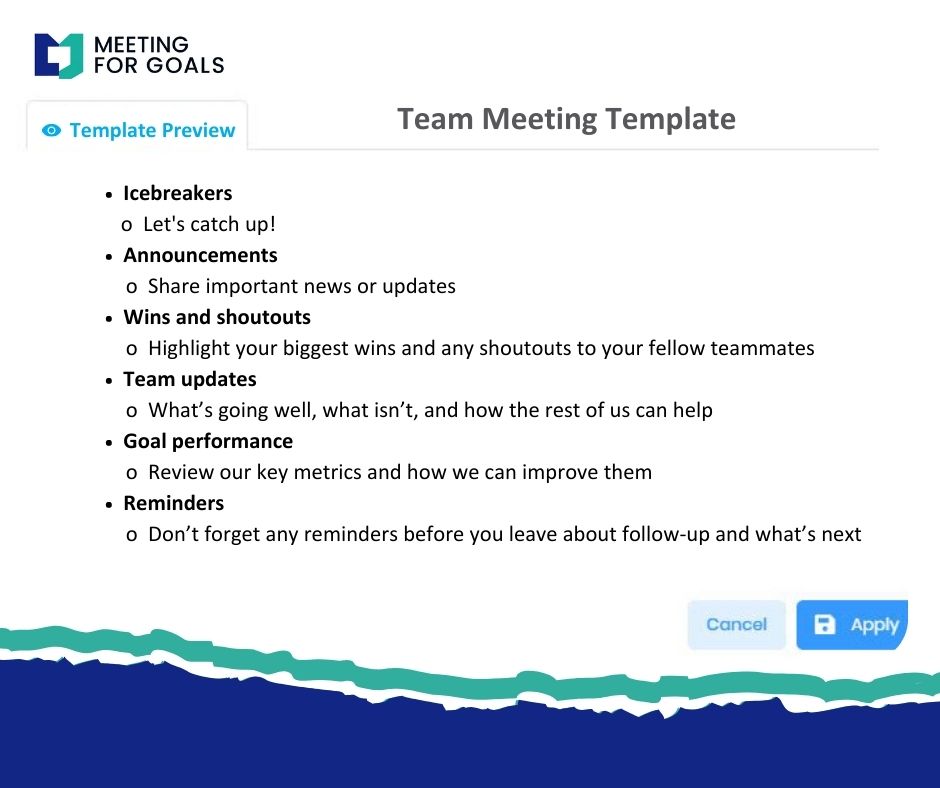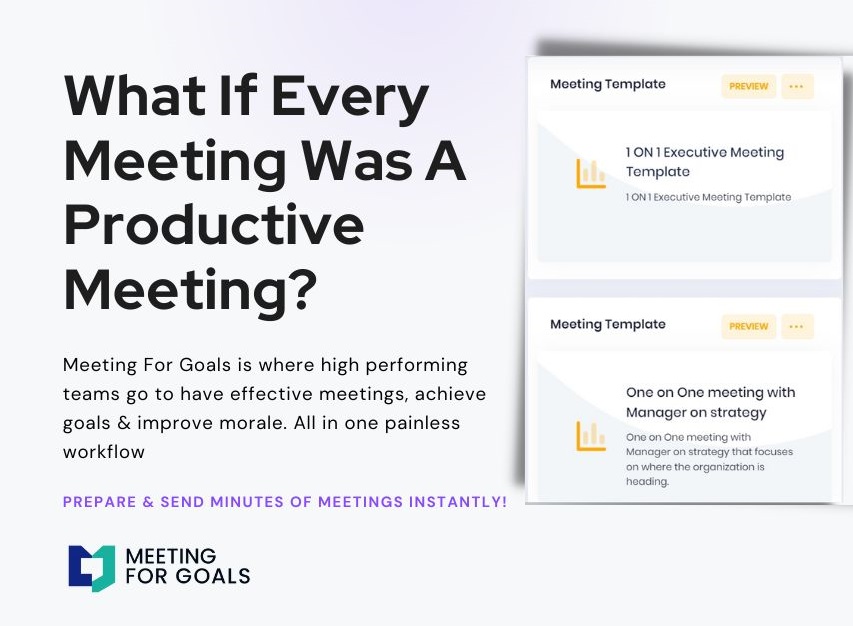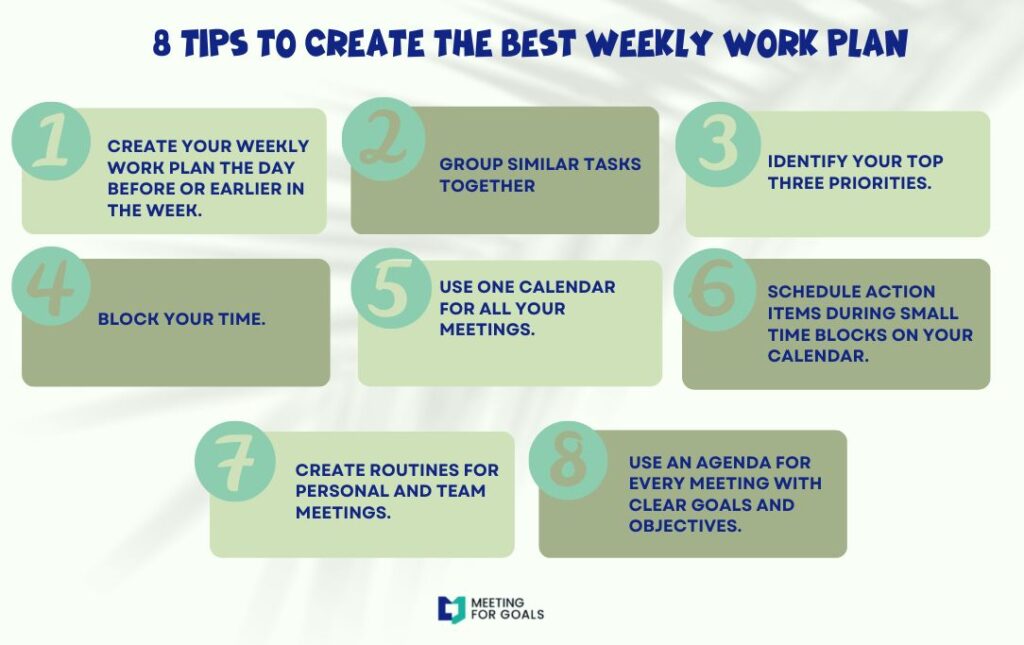Mastering Hybrid Meetings: A Complete Guide for High-Performing Teams
In today’s rapidly changing work environment, hybrid meetings have become essential. With teams spread across cities, countries, and time zones, businesses must find new ways to communicate effectively. Hybrid meetings—where some people join in person and others dial in remotely—offer a flexible solution. However, they also come with their own set of challenges.
This guide breaks down everything you need to know about hybrid meetings. Whether you’re a Director, VP, or C-suite executive, you’ll discover how to run meetings that are productive, inclusive, and aligned with your goals. You’ll also learn how Meeting For Goals can help you streamline your process and get better results from every meeting.
If you’re ready to take your meetings to the next level, check out our free meeting templates at https://meetingforgoals.com/meeting_templates or sign up today at https://app.meetingforgoals.com/TenantRegistration/Register.
I. Introduction
The workplace has changed forever. Remote work, flexible schedules, and distributed teams are the new normal. In this new reality, hybrid meetings have emerged as a key strategy for keeping everyone connected and aligned.
So, what is a hybrid meeting? Simply put, it’s a meeting where some participants are in a physical room while others join remotely via video conferencing. This setup combines the immediacy of face-to-face interaction with the convenience of remote access.
For companies with 40–70 employees, especially those led by senior executives, effective meetings are critical. You’re responsible for aligning your team, setting goals, and driving performance. That’s where Meeting For Goals comes in.
Meeting For Goals is a smart meeting management platform built for high-performing teams. It helps you plan, run, and follow up on meetings with ease. Whether your team is remote, in-office, or hybrid, our platform ensures that every meeting is focused, efficient, and goal-driven.
In this guide, we’ll explore the benefits of hybrid meetings, the common pitfalls, and the best practices that successful teams follow. By the end, you’ll know how to make hybrid meetings work for your team—and how Meeting For Goals can help you every step of the way.
2 Minute Video
Watch a 2 minute demo of our meeting management software in action.
II. Advantages of Hybrid Meetings
Hybrid meetings offer several key benefits that make them ideal for today’s dynamic work environment.
A. Flexibility for Everyone
One of the biggest perks of hybrid meetings is flexibility. Team members can choose how they attend—whether from the office, home, or while traveling. This freedom makes it easier to maintain momentum, even when people are on the go.
For leaders, this means higher attendance and more consistent engagement. When people can join from anywhere, meetings become more accessible and efficient.
B. Inclusion for Remote Employees
In traditional in-person meetings, remote employees often feel like outsiders. They miss out on side conversations, body language, and spontaneous brainstorming.
Hybrid meetings, when done right, level the playing field. Everyone gets the same information and the same opportunity to contribute. This inclusion boosts morale and helps remote workers feel like true members of the team.
C. Better Collaboration Across Locations
Hybrid meetings make it easier to bring together diverse perspectives. A sales rep in New York can share insights with a product manager in London. A designer in Austin can brainstorm with a marketer in Toronto.
This cross-functional collaboration leads to more creative solutions. It also helps teams stay aligned across time zones and departments.
D. Lower Travel Costs
Flying people in for meetings is expensive. Hybrid meetings reduce the need for travel, saving money on flights, hotels, meals, and more.
These savings can be reinvested in training, tools, or team-building activities. Plus, reducing travel supports your company’s sustainability goals—something that matters more than ever.
According to a report by McKinsey & Company, flexible work models, including hybrid meetings, are not just a trend—they’re a long-term shift that improves both productivity and employee satisfaction. You can read the full report here: https://www.mckinsey.com/business-functions/people-and-organizational-performance/our-insights/the-future-of-work-after-covid-19
Adding an Agenda
How to add an agenda instantly on Meeting For Goals.
III. Challenges of Hybrid Meetings
While hybrid meetings offer many advantages, they also present unique challenges that can disrupt communication and engagement.
A. Technology Glitches
Let’s face it—tech issues happen. Poor Wi-Fi, frozen screens, and audio dropouts can ruin a meeting. For remote participants, this can lead to missed information and frustration.
To avoid this, invest in reliable hardware and software. Meeting For Goals integrates with Zoom, Google Meet, and Microsoft Teams, making it easy to stay connected and organized no matter where your team is.
B. Unequal Participation
In-person attendees often dominate the conversation. Remote participants may feel like they’re watching a show instead of being part of it.
Meeting facilitators need to be proactive. Use tools like Meeting For Goals to assign speaking turns, prompt quieter voices, and ensure everyone is heard.
C. Communication Gaps
Body language and facial expressions are harder to read on a screen. This can lead to misunderstandings or missed cues.
To bridge the gap, establish clear communication norms. Speak one at a time. Summarize key points. Use Meeting For Goals to document decisions and keep everyone on the same page.
D. Time Zone Conflicts
Scheduling across time zones is tricky. Someone always ends up joining at an inconvenient hour.
While there’s no perfect solution, rotating meeting times and using asynchronous updates can help. Meeting For Goals allows you to share notes, action items, and recordings so no one is left out.
E. Meeting Fatigue
Hybrid meetings can drag on if they’re not well-structured. People tune out, multitask, or drop off early.
That’s why structure is so important. With Meeting For Goals, you can create focused agendas, assign time limits, and keep discussions on track—so meetings are productive and to the point.
IV. Best Practices for Hybrid Meetings
To get the most out of hybrid meetings, you need more than just a video link. Here’s how high-performing teams make it work.
A. Always Start With a Clear Agenda
A clear agenda sets the tone. It tells everyone what to expect and what’s expected of them.
With Meeting For Goals, you can build and share agendas in advance. Assign topics, link them to goals, and keep the team focused from start to finish.
B. Use the Right Tools
Good tools make all the difference. You need reliable video conferencing, strong internet, and a platform that brings everything together.
Meeting For Goals does just that. It syncs with your video tools, stores your notes, tracks action items, and aligns every meeting with your objectives.
C. Make Participation Equal
Encourage everyone to speak up. Use round-robin check-ins, polls, or breakout groups.
Meeting For Goals even tracks who’s speaking and who’s not—so you can make sure everyone is involved. This data can help you adjust your approach and improve future meetings.
D. Add a Human Touch
Start with a quick icebreaker. Ask a fun question or do a 2-minute team-building activity. This helps break the ice and builds rapport between in-person and remote attendees.
Interactive tools like whiteboards or live Q&A can also keep energy levels high. Meeting For Goals supports real-time collaboration so your team stays engaged.
E. Assign Roles
Assign a facilitator, timekeeper, and note-taker. This keeps the meeting organized and ensures nothing falls through the cracks.
Meeting For Goals makes it easy to assign and track roles, so your team knows who’s doing what—before, during, and after the meeting.
F. Follow Up Fast
After the meeting, send out notes and action items right away. This reinforces accountability and keeps momentum going.
Meeting For Goals automatically generates follow-up tasks and sends reminders, so nothing gets forgotten.
V. Measuring Success
Want to make your meetings better? Start by measuring what’s working—and what’s not.
A. Track Key Metrics
Use KPIs to evaluate your meetings. Some useful ones include:
- Attendance rates
- Completion of action items
- Time spent vs. time planned
- Participant engagement
- Feedback scores
Meeting For Goals tracks all of these automatically, giving you a clear picture of your meeting performance.
B. Ask for Feedback
After each meeting, ask attendees how it went. Were the objectives clear? Did they feel included? Was the meeting a good use of time?
Use quick surveys or polls. Meeting For Goals has built-in feedback tools that let you gather and analyze responses in real time.
C. Make Data-Driven Improvements
Use the insights you gather to improve. If remote attendees feel left out, assign a co-facilitator to represent them. If meetings run long, trim your agenda or tighten time limits.
Meeting For Goals provides actionable suggestions based on your data. This helps you fine-tune your meeting strategy and get better results over time.
D. Build a Culture of Continuous Improvement
Make feedback and improvement part of your team culture. Celebrate wins, learn from challenges, and keep evolving.
According to a recent article by Harvard Business Review, companies that continuously improve their meeting practices see higher employee satisfaction and better business outcomes. Read more here: https://hbr.org/2022/03/what-makes-some-virtual-teams-better-than-others
VI. Conclusion
Hybrid meetings are more than a trend—they’re a necessity. They offer flexibility, inclusivity, and cost savings. But to make them truly effective, you need the right approach and the right tools.
By understanding the benefits, addressing the challenges, and following best practices, you can turn your hybrid meetings into powerful engines of collaboration and productivity.
Meeting For Goals is here to help. Our platform gives you everything you need to plan, run, and improve your meetings—from agenda templates to performance tracking and real-time feedback.
If you’re ready to lead better meetings and drive better outcomes, start by exploring our free meeting templates at https://meetingforgoals.com/meeting_templates. Or sign up now at https://app.meetingforgoals.com/TenantRegistration/Register and see how Meeting For Goals can transform your team’s performance.
Let’s make every meeting count. Visit https://meetingforgoals.com to learn more.



